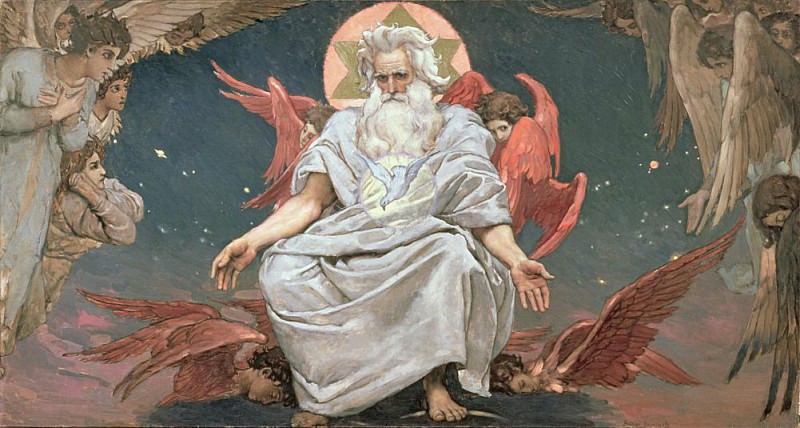Savaoph, God the Father Viktor Vasnetsov (1848-1926)
Viktor Vasnetsov – Savaoph, God the Father
Edit attribution
Download full size: 1001×535 px (0,1 Mb)
Painter: Viktor Vasnetsov
Location: The State Tretyakov Gallery, Moscow (Государственная Третьяковская галерея).
A master of Russian painting, Viktor Vasnetsov completed an intense work on the painting God of Sabaoth in 1896. The painting depicts a Christian deity called the Lord of powers. Other sources relate his activities to the wars of liberation for the benefit of the captive Jewish people. The account of this mythical hero is found in the pages of the Old Testament. Absolute power is attributed to this God.
Description of Victor Vasnetsov’s painting God of Sabaoth
A master of Russian painting, Viktor Vasnetsov completed an intense work on the painting God of Sabaoth in 1896. The painting depicts a Christian deity called the Lord of powers. Other sources relate his activities to the wars of liberation for the benefit of the captive Jewish people.
The account of this mythical hero is found in the pages of the Old Testament. Absolute power is attributed to this God. The general consensus is that he is the sole lord of the earth, the heavens and the stars.
This is also how the artist depicts him. He paints an omnipotent old man in a radiant, snow-white tunic, whose strong arms are outstretched in an open gesture. The lord opens his palms to us, as if to communicate the goodness of his intentions. His deep, calm gaze, wise by centuries of experience, looks not at the spectator, but somewhere inside the consciousness of the deity himself. He is simultaneously with us and somewhere in his thoughts. His face is surrounded by a sphere with a clearly marked five-pointed star, covered by gray strands of hair. In the center of the figure of the sage Vasnetsov marked a large golden circle in which there is a young dove.
Apparently, this symbolizes the desire for harmony, purity and peace in the universe. The surroundings of God are quite unusual. Right around him are mythical creatures with the bodies of fiery birds and human heads. They cling closely to the lord, lap his shoulders and bow to his very feet.
The fabulous Syrians froze with an expression of awe on their meek faces. A little away from the center of the canvas we see angelic beings bowing their faces in silent worship. One of the angels stands before the great Savior, looking at him continuously with admiring eyes, his arms crossed over his chest in the shape of a cross. It is as if he is trusting the deity with all his aspirations.
Кому понравилось
Пожалуйста, подождите
На эту операцию может потребоваться несколько секунд.
Информация появится в новом окне,
если открытие новых окон не запрещено в настройках вашего браузера.
You need to login
Для работы с коллекциями – пожалуйста, войдите в аккаунт (open in new window).




















COMMENTS: 1 Ответы
Самое милое дело – рисовать то, чего никогда не видел. Резвись, душа!
You cannot comment Why?
Surrounding God are numerous angels. Some are bright and ethereal, appearing in various poses of worship or awe. Others are depicted with fiery, red wings, suggesting a more active or warrior-like celestial host. These figures are arranged in a dynamic composition, with some reaching upwards and others looking towards God, creating a sense of movement and reverence.
Behind God, a radiant halo in the form of a six-pointed star illuminates him, further emphasizing his divine status. The background is a deep, starry sky, hinting at the vastness of creation.
The subtexts of the painting are deeply rooted in Christian iconography and theology. The central figure of God the Father represents the ultimate creator and sustainer of the universe. The presence of the Holy Spirit (the dove) and the surrounding angels signifies the divine trinity and the heavenly host that serves God. The various depictions of angels, from the gentle to the formidable, likely represent different orders or roles within the celestial realm. The overall atmosphere of the painting is one of cosmic grandeur, divine power, and the awe-inspiring relationship between the divine and the earthly. The composition and the figures evoke a sense of divine judgment, creation, and omnipresence.